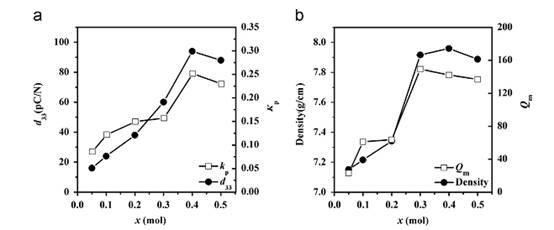Piezoelectric ceramics with a high Curie temperature (Tc) are critical materials for various piezoelectric sensors and actuators working at elevated temperatures, particularly those for aerospace and automotive industries. And the perovskitetype ceramic systems with the general form BiMeO3–PbTiO3 (BMePT), where Me can be a single or mixture of cations with an average valence of +3, show both a high Tc and a high piezoelectric coefficient d33.
However, because of the low mechanical quality factor (Qm) of BMePT, complex perovskite high temperature ceramics with improved Qm(and hence a low dissipated energy) are highly desirable. Although BiYbO3–PbTiO3 (BYPT) has a very high Tc up to 630 °C, its d33 is very low, and the large difference in tolerance factor of BY and PT causes difficulties in fabrication.
To improve the material stability and the piezoelectric properties, PZN (a typical relaxor with a moderate tolerance factor of 0.986) is added to BYPT and a new high temperature (1?x)(0.1BiYbO3–0.9PbTiO3)–xPb(Zn1/3Nb2/3)O3 [(1?x)BYPT–xPZN] ternary system with a much higher Qm is fabricated. In this research, the microstructure and electrical properties of this new system were reported.
The ternary system had a perovskite main phase with a tetragonal symmetry. With increasing PZN content (Fig. 1), the tetragonality decreased, and interestingly, both the piezoelectric properties and Qm of the samples were largely improved. Microstructural characteristics indicated that the improved piezoelectric performance was also due to the improved density, structural stability and homogeneity. More importantly, the depolarization temperature of this new system was found to be higher than 350 °C, although the Tc is around 400 °C.

Fig.1 Some electric parameters and density data of various (1?x)BYPT–xPZN ceramic samples. (a)x dependence of piezoelectric coefficient d33 and the planar electromechanical coupling factor (b) x dependence of Qm and density (Image by GUO).
This research was supported by the National Key Basic Research Program of China (973 Program) (Grant No. 2013CB63 2900) and the National Science Foundation of China (NSFC No. 11074277).
The research “Structure and Electrical Properties of (1?x)(0.1BiYbO3–0.9PbTiO3)–xPb(Zn1/3Nb2/3)O3 High-temperature Ternary Piezoelectric Ceramics” has been published in the journal of Materials Letters (Volume 114, 1 January 2014, Pages 100–102).
Corresponding author:
GUO Dong
Institute of Acoustics, Chinese Academy of Sciences, Beijing, 100190, China
Email: dong.guo@mail.ioa.ac.cn


